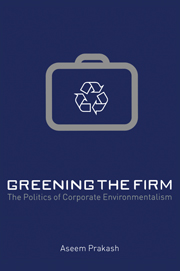Book contents
3 - Baxter and Lilly: evolution of environmental programs
Published online by Cambridge University Press: 22 September 2009
Summary
The previous chapter outlined a theoretical approach to “unpack” firms for studying their internal policy dynamics on environmental issues. This chapter examines the evolution of the environmental function in Baxter and Lilly. It describes and compares their internal environmental policy-making structures. Both Baxter and Lilly have come a long way in developing and institutionalizing their environmental programs. Baxter's and Lilly's experiences are fairly representative of large US firms which confronted a new set of managerial challenges in the 1970s in the health, safety, and environmental spheres. Though many challenges have yet to be tackled, it is fair to say that most firms have undergone a fundamental transformation on how they relate their functioning and policies to the natural environment. This transformation, however, is uneven within and across firms and can be attributed to factors internal and external to firms. The next chapter focuses on the key events in the evolution of Baxter's and Lilly's environmental programs. These cases are examined by employing power-based and leadership-based theories
Baxter: an overview
Baxter International Inc. is a Deerfield, Illinois-based multinational corporation that develops, manufactures, and markets products and services used in hospitals and other health-care settings. On October 1, 1996, a part of Baxter International Inc. was spun off into an independent firm called Allegiance Corporation. As shown in table 3.1 below, the 1995 net sales of undivided Baxter International Inc. (henceforth Baxter) stood at $9.6 billion, and research and development expenditure at $351 million.
- Type
- Chapter
- Information
- Greening the FirmThe Politics of Corporate Environmentalism, pp. 34 - 57Publisher: Cambridge University PressPrint publication year: 2000



